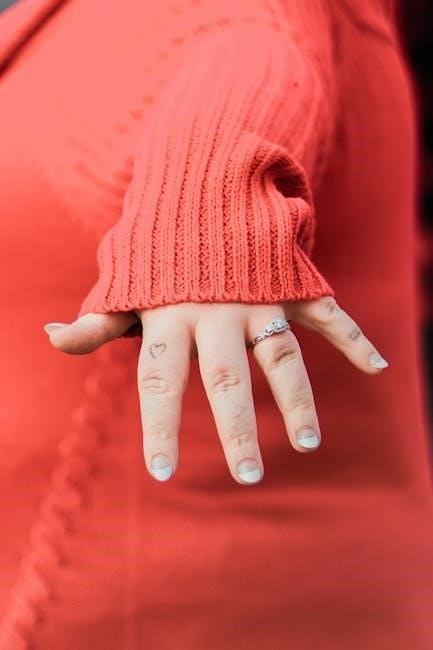The crochet magic ring‚ also known as the magic loop or circle‚ is a fundamental technique for starting round projects seamlessly. It eliminates the central hole‚ making it ideal for amigurumi‚ hats‚ and granny squares. This method is adjustable‚ allowing for a perfect fit. Popular among crocheters‚ it offers a clean‚ professional finish.
1.1 What is the Magic Ring?
The Magic Ring‚ also known as the Magic Loop or Magic Circle‚ is a versatile crochet technique used to start projects worked in the round. It creates an adjustable loop that allows you to pull the center tight‚ eliminating the hole often left by traditional methods. This technique is especially popular for amigurumi toys‚ hats‚ and granny squares‚ as it provides a seamless and professional finish. The Magic Ring is a foundational skill for crocheters‚ offering precision and control over the starting point of circular projects. Its adaptability makes it suitable for both beginners and experienced crafters‚ ensuring a clean and polished beginning to any round crochet design.
1.2 Importance of the Magic Ring in Crochet
The Magic Ring is a cornerstone technique in crochet‚ offering a neat and professional start to round projects. Its ability to eliminate unsightly gaps makes it indispensable for creating seamless bases‚ especially in amigurumi toys‚ hats‚ and granny squares. Unlike traditional methods that often leave visible holes‚ the Magic Ring ensures a clean and polished finish. This technique is also highly versatile‚ accommodating various stitch types and project sizes. Whether you’re a beginner or an experienced crocheter‚ the Magic Ring enhances the quality of your work‚ making it a must-learn skill for anyone looking to elevate their crochet creations. Its simplicity and effectiveness have made it a favorite among crafters worldwide.

What is the Magic Ring?
The Magic Ring‚ also called the Magic Loop or Magic Circle‚ is an adjustable starting technique for crochet projects. It eliminates holes‚ creating a seamless base.
2.1 Definition and Purpose
The Magic Ring is a versatile crochet technique used to start projects worked in the round‚ such as amigurumi‚ hats‚ and granny squares. Its primary purpose is to create a seamless‚ adjustable starting point without leaving a hole at the center. Unlike traditional methods that rely on chains‚ the Magic Ring allows crocheters to adjust the tightness of the loop‚ ensuring a professional finish. This technique is especially popular for amigurumi toys‚ where a tight‚ clean center is essential. The Magic Ring is also known as the Magic Loop or Magic Circle‚ emphasizing its adaptability and effectiveness in various crochet designs. It is a fundamental skill for both beginners and experienced crocheters.
2.2 Terminology: Magic Ring‚ Magic Loop‚ Magic Circle
The terms Magic Ring‚ Magic Loop‚ and Magic Circle are often used interchangeably in crochet to describe the same foundational technique. They all refer to an adjustable starting point for projects worked in the round. The Magic Ring is the most commonly used term‚ while Magic Loop and Magic Circle emphasize the circular nature of the technique. These terms describe a method where a loop is created with the yarn‚ allowing the crocheter to work stitches directly into it. The key feature is its adjustability‚ enabling the creation of a seamless‚ hole-free center. This technique is especially popular for amigurumi toys‚ hats‚ and granny squares‚ where a clean‚ professional finish is desired. The terminology may vary slightly between patterns and tutors‚ but the core concept remains consistent.

Why Use the Magic Ring?
The magic ring eliminates the central hole‚ creating a seamless and professional finish. It’s versatile‚ adjustable‚ and ideal for projects like amigurumi‚ hats‚ and granny squares.
3.1 Advantages Over Traditional Methods
The magic ring offers several advantages over traditional crochet methods. It eliminates the unsightly hole often left when starting projects in the round‚ creating a seamless and polished appearance. Unlike the chain method‚ the magic ring allows for an adjustable loop‚ making it easier to control the number of stitches. This technique is particularly beneficial for amigurumi toys‚ hats‚ and granny squares‚ where a tight‚ clean center is desired. Additionally‚ the magic ring is less bulky‚ providing a more professional finish. Its versatility and ease of use make it a preferred choice for crocheters of all skill levels‚ from beginners to experienced crafters.
3.2 Versatility in Projects
The magic ring technique is incredibly versatile‚ making it suitable for a wide range of crochet projects. It is ideal for creating amigurumi toys‚ hats‚ headbands‚ and granny squares‚ where a seamless‚ adjustable start is essential. The magic ring also works beautifully for bags‚ scarves‚ and other accessories‚ providing a clean and professional finish. Its adaptability allows it to be used with various stitch types‚ from single crochet to double or triple crochet‚ depending on the project’s requirements. Whether you’re making a small toy or a large blanket‚ the magic ring offers a reliable and elegant way to begin. This technique is perfect for both beginners and experienced crocheters‚ making it a must-have skill for any crochet enthusiast.

Materials Needed
To create a magic ring‚ you’ll need a crochet hook and yarn of your choice. Ensure the yarn tail is long enough for sewing‚ typically around 10 cm.
4.1 Yarn and Hook Selection
Choosing the right yarn and hook is essential for a successful magic ring.Medium-weight yarn with good stitch definition works best‚ while finer yarns can be tricky for beginners. Select a hook size recommended on the yarn label to ensure proper tension. For tight stitches‚ aluminum or steel hooks are ideal‚ whereas resin hooks are better for a looser fit. The yarn tail length should be around 10 cm to allow for easy sewing. Always consider the project’s requirements‚ as different patterns may call for specific yarn weights or fibers. Swatching before starting ensures the hook and yarn combination will produce the desired fabric. Proper selection enhances both the process and the final result.
4.2 Tail Length Consideration
The yarn tail length is crucial for creating a magic ring. A tail of about 10 cm is ideal‚ as it allows enough length to pull tight and secure the ring without excess yarn. Too short a tail may make it difficult to close the ring properly‚ while too long a tail can be cumbersome to work with. The tail should be long enough to weave in seamlessly after closing the ring. Proper tension is key; the tail should be taut but not overly tight‚ ensuring the ring lies flat. Managing the tail effectively ensures a neat‚ professional finish to your crochet project.
Step-by-Step Guide to Creating a Magic Ring
Creating a magic ring involves forming a loop‚ securing it with stitches‚ and adjusting the tension. Start by making a slip knot‚ then crochet stitches into the loop‚ and pull the tail to tighten. This method ensures a seamless‚ hole-free center for round projects.
5.1 Preparing the Loop
Preparing the loop is the first step in creating a magic ring. Begin by holding the yarn in your non-dominant hand‚ making a loop with the tail end. Ensure the loop is large enough to accommodate the number of stitches you plan to crochet. The loop should not be too tight‚ as it needs to be adjustable. Hold the working yarn in your dominant hand‚ ready to insert the hook. This initial setup is crucial for a smooth process. Keep your hands steady and the yarn taut but not overly tight. Proper preparation ensures the loop is workable and even.
5.2 Working the First Stitches
With the loop prepared‚ insert the crochet hook into the center. Crochet your first stitch‚ typically a slip knot‚ to secure the loop. Work the initial stitches evenly around the loop‚ ensuring they are not too tight or loose. For single crochet‚ double crochet‚ or other stitches‚ maintain consistent tension. As you crochet‚ gently pull the yarn tail to adjust the loop size. This step ensures the stitches lie flat and the ring remains adjustable. Properly worked first stitches are essential for a seamless foundation. Keep the tension even to avoid puckering or gaps. This process sets the stage for a professional-looking project.
5.3 Adjusting and Closing the Ring
Once the first stitches are worked‚ gently pull the yarn tail to tighten the ring. Adjust the size by tugging evenly on both ends of the yarn tail. Ensure the ring is snug but not overly tight‚ as this can cause puckering. To close the ring‚ pull the tail firmly to secure the stitches. If needed‚ use a tapestry needle to weave the tail through the stitches to reinforce the closure. Properly closing the ring ensures a seamless foundation for your project. Always check the tension before finalizing‚ as this step is crucial for a professional finish. Once closed‚ the magic ring should lie flat‚ ready for further crocheting.

Tutorials for Learning the Magic Ring
Detailed video and photo tutorials are available online‚ offering step-by-step guidance for crocheters of all skill levels. Many free PDF guides‚ like those from Interweave‚ provide clear instructions.
6.1 Video Tutorials
Video tutorials are an excellent way to master the magic ring technique‚ offering visual step-by-step guidance. Platforms like YouTube and crochet websites provide numerous free videos‚ catering to both left- and right-handed learners. These tutorials often include close-ups‚ making it easier to follow along. Many videos are designed for beginners‚ breaking down the process into simple‚ manageable steps. Some tutorials also cover variations‚ such as the double magic ring‚ and demonstrate how to apply the technique to various projects like amigurumi toys or hats. With clear instructions and real-time demonstrations‚ video tutorials are a valuable resource for crocheters of all skill levels. They are especially helpful for visual learners‚ ensuring a seamless learning experience.
6.2 Photo Tutorials
Photo tutorials are a fantastic resource for learning the magic ring technique‚ especially for visual learners. Websites like Planet June and Interweave offer detailed step-by-step photo guides‚ often accompanied by large‚ clear images. These tutorials break down the process into manageable parts‚ showing each stitch and loop formation. Many free PDF guides‚ such as those from Interweave‚ include high-quality photographs to illustrate the technique. Photo tutorials are particularly helpful for beginners‚ as they provide a clear visual reference for creating the magic ring. They are also useful for understanding how to adjust the ring and close it properly. With these resources‚ crocheters can follow along at their own pace‚ ensuring a seamless learning experience.

Troubleshooting Common Issues
Common issues with the magic ring include gaps and overly tight stitches. Adjusting tension and ensuring even stitching helps prevent these problems.
7.1 Preventing Gaps
Preventing gaps in a magic ring requires attention to tension and stitch placement. Ensure the initial loop is snug but not overly tight. When crocheting the first round‚ keep stitches evenly spaced and avoid pulling the yarn too tightly‚ as this can create looseness. Using the correct hook size for the yarn helps maintain consistency. After completing the stitches‚ gently pull the tail to tighten the ring. This step is crucial for a seamless join. Proper technique ensures a neat‚ gap-free center‚ especially important for projects like amigurumi or granny squares. Practice makes perfect in achieving the ideal tension.
7.2 Fixing a Too-Tight Ring
If a magic ring becomes too tight‚ it can be challenging to work with‚ especially if stitches are missed. To fix this‚ gently loosen the ring by tugging the tail slightly. If the ring is excessively tight‚ it may be necessary to unravel the stitches and restart. Ensuring the initial loop has a bit of slack can prevent this issue. Using a larger hook size can also help achieve a more manageable ring. Proper technique and patience are key to avoiding overly tight rings. Remember‚ it’s better to adjust early than to struggle with a tight foundation. Practice helps in mastering the right tension.
Resources for Further Learning
Discover extensive free PDF guides and detailed tutorials on websites like Interweave and Planet June. These resources offer video and photo tutorials for mastering the magic ring technique.
8.1 Free PDF Guides

Several websites offer free PDF guides to help you master the crochet magic ring technique. Interweave provides a detailed booklet with clear steps and photos‚ requiring an email sign-up for access. Planet June offers comprehensive tutorials tailored for both left- and right-handed crocheters‚ complete with videos and photos. Additionally‚ Janie Crow’s guide includes a step-by-step method for creating the magic ring‚ while Crochet Me offers a free eBook with patterns to practice your skills. These resources are invaluable for beginners and experienced crocheters alike‚ ensuring a seamless learning experience. They often include additional tips and patterns to enhance your crochet journey.
8.2 Recommended Websites
For comprehensive resources on the crochet magic ring‚ several websites stand out. Planet June offers detailed tutorials with videos and photos‚ catering to both left- and right-handed crocheters. Moogly provides clear step-by-step guides and tips for mastering the technique. The Crochet Crowd features community-driven content‚ including video tutorials and patterns. Crochet Geek offers in-depth instructions tailored for all skill levels. These websites are excellent for learning the magic ring‚ with many offering free patterns and troubleshooting tips. They are ideal for both beginners and experienced crocheters‚ ensuring a smooth learning process. Their resources are well-organized and accessible‚ making them go-to destinations for perfecting the magic ring technique.
Projects Using the Magic Ring
The magic ring technique enhances various crochet projects‚ such as amigurumi toys‚ hats‚ and granny squares‚ providing a seamless and professional finish.
9.1 Amigurumi Toys
The magic ring technique is a cornerstone of amigurumi crochet‚ enabling the creation of seamless‚ professional-looking toys. Amigurumi‚ which translates to “knitted or crocheted stuffed toy” in Japanese‚ relies on a tight‚ gapless center to achieve the desired appearance. By using the magic ring‚ crocheters can start their projects without leaving unsightly holes‚ ensuring a neat and polished finish. This method is particularly ideal for beginners‚ as it simplifies the process of working in the round. Whether crafting cute animals‚ dolls‚ or other whimsical designs‚ the magic ring provides the perfect foundation. Its adjustability ensures that the starting point can be tightened or loosened as needed‚ making it a versatile tool for amigurumi enthusiasts.
9.2 Hats and Headbands
The magic ring technique is a game-changer for crocheting hats and headbands‚ as it allows for a seamless join at the beginning of the project. This method eliminates the unsightly hole often left by traditional methods‚ ensuring a clean and professional-looking brim or band. Whether you’re making a slouch hat‚ beanie‚ or stylish headband‚ the magic ring provides a smooth‚ polished start. It’s particularly useful for projects where a neat‚ invisible join is essential. The magic ring is also versatile‚ working well with various yarn weights and stitch patterns. This technique is a must-try for anyone aiming to create high-quality‚ professional-looking hats and headbands. Its ease of use makes it perfect for both beginners and experienced crocheters.

9.3 Granny Squares
The magic ring technique is a fantastic way to start a Granny Square‚ ensuring a seamless and professional-looking project from the very beginning. Traditional Granny Squares often begin with a chain ring‚ which can leave a small hole in the center. By using the magic ring‚ you eliminate this gap‚ creating a clean and polished start. This method is particularly useful for Granny Squares‚ as it maintains the classic look while enhancing the overall quality. The magic ring is versatile and works beautifully with the vibrant colors and stitch patterns typical of Granny Squares. Whether you’re making a single square or an entire afghan‚ this technique will elevate your project. It’s a modern twist on a timeless crochet classic‚ making it a must-try for crafters of all skill levels.

The magic ring is a versatile and essential technique in crochet‚ offering a professional finish and seamless start for various projects. Keep practicing to master it!
10.1 Summary of Benefits

The magic ring offers numerous advantages‚ including a seamless start for round projects‚ eliminating central holes‚ and providing an adjustable fit. It enhances the appearance of amigurumi‚ hats‚ and granny squares. The technique is versatile‚ suitable for various yarns and hooks‚ and is especially beneficial for beginners and experienced crocheters alike. Its adjustability ensures a perfect fit‚ while the absence of gaps creates a clean‚ professional finish. Resources like video and photo tutorials‚ along with free PDF guides‚ make mastering the magic ring accessible to all skill levels. This method is a must-learn for anyone looking to elevate their crochet projects.
10.2 Encouragement to Practice
Mastering the magic ring is an essential skill for any crocheter‚ offering endless possibilities for creative projects. While it may seem intimidating at first‚ consistent practice will quickly build confidence and proficiency. Begin with simple projects like amigurumi toys or granny squares to see immediate results. The availability of free PDF guides‚ video tutorials‚ and photo tutorials makes learning accessible and straightforward. Don’t be discouraged by initial challenges—each stitch brings you closer to mastering this versatile technique. With patience and dedication‚ you’ll soon create beautiful‚ professional-looking pieces. Keep experimenting and enjoying the process‚ as the magic ring will undoubtedly become a cornerstone of your crochet journey.
